Shedless Dogs For People With Canine Allergies
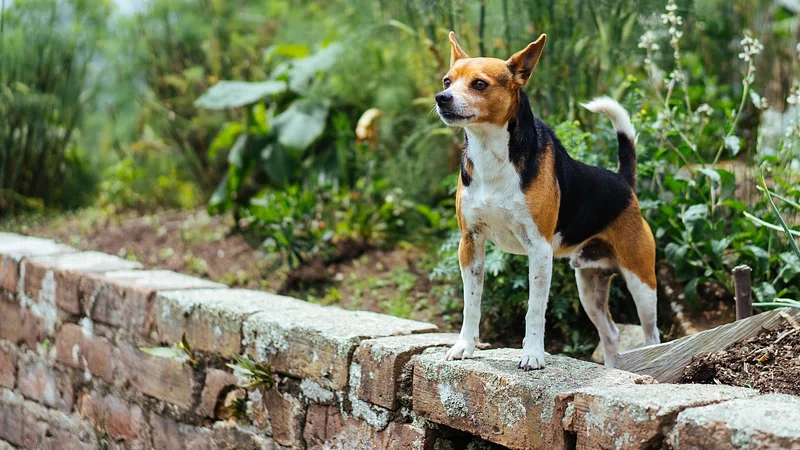
Here’s The problem: Allergies. When we think of allergies we tend to think first about dog hair, but that’s not the real culprit; dander is. Dander is dead skin that flakes off. If a dog sheds a lot, its hair can spread dander all over the place. Floating hairs or un-brushed animals will add a lot to the dander problem. Dander can cause asthma attacks, allergic reactions, nasal infections and lots of general discomforts.
What is the solution? Hypoallergenic dogs. While this isn’t a reality, there are breeds of dogs that have little to no dander. Those that are particularly sensitive might still be allergic to the breeds that we’ve chosen, but the good news is that they’ll alleviate all but the worst allergies. After we talk about breeds, we’ll also discuss best practices HERE that will help you limit and contain allergens.
What We Considered In Creating This List:
- Popularity
- Exercise Requirements
- Compatibility with Children
- Intelligence
Popularity is important because it is the single easiest factor to use to determine the difficulty and cost of getting a dog in that breed. You may get lucky and live next door to a world-class breeder, but for the most part, you’ll be able to tell how easily you can get a dog by the popularity of its breed.
Exercise needs are vital when choosing a dog. Think about your space and your willingness to commit to your animal when choosing your breed: a happy dog makes a happy owner.
Compatibility with Children is central to your successful ownership of a dog for anyone who has children, For the sake of the dog and your children, please carefully consider whether the dog will get along with the specific needs of your house.
Intelligence is simply how smart the dog is. Bored dogs are destructive dogs, so be mindful of this fact: the smarter your dog is, the more you need to invest in keeping it entertained. This means the investment of your mind, energy, and wallet. Smart dogs are the most rewarding for an involved owner, but also the most irritating for one that doesn’t want to be engaged all of the time.
Hop To Your Section:
- Small Breeds
- Medium-sized Breeds
- Large Dog Breeds
Or, just keep on reading…
#1 Yorkshire Terrier
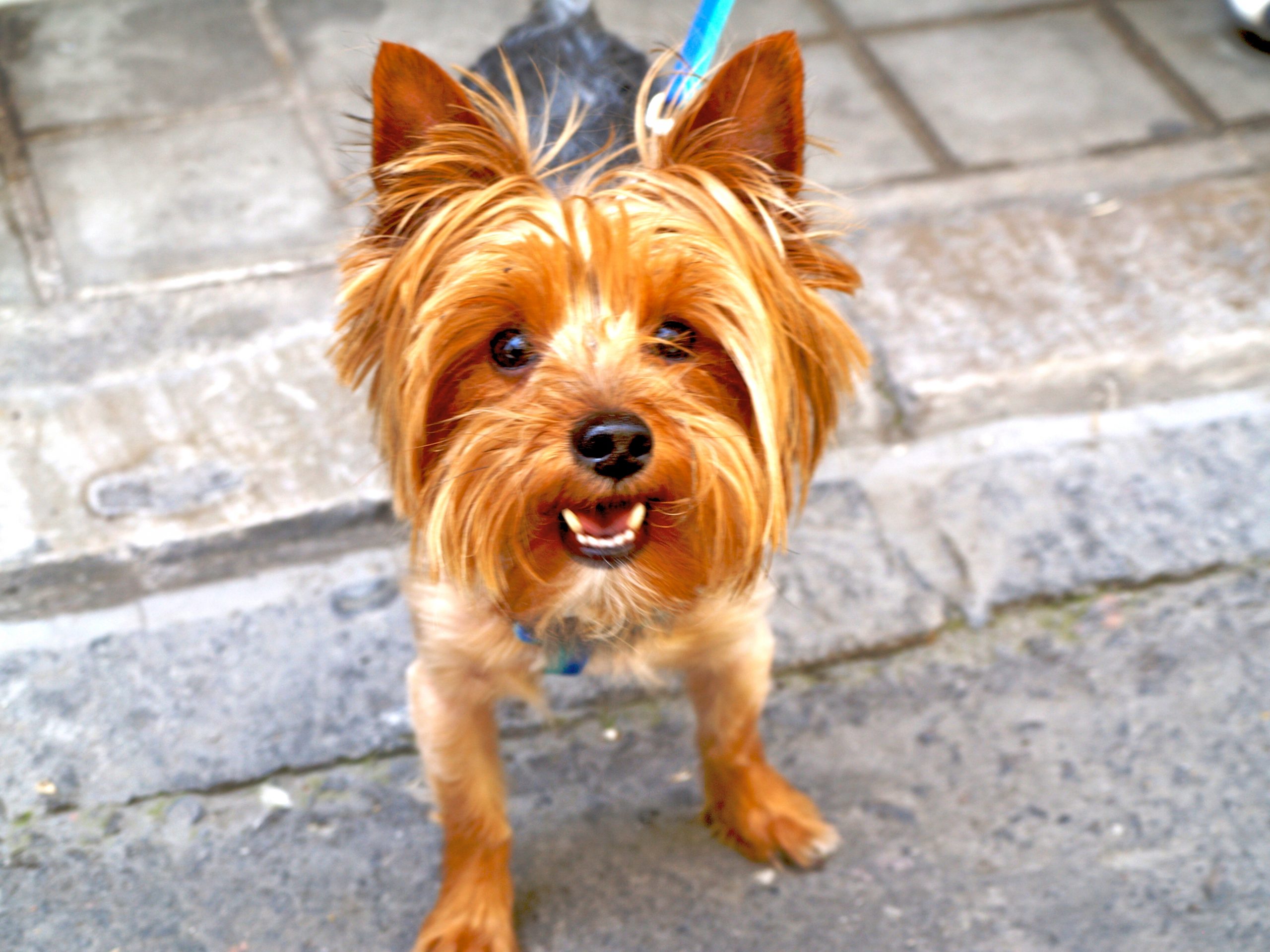
Yorkshire Terriers, or “Yorkies,” are an excellent choice for an indoor companion dog. What began as a breed to hunt rats in the factories of 18th Century England soon grew to be one of the most popular breeds on our list. Currently, they’re the 6th most popular pure-breed in the United States.
Yorkshire Terriers are energetic, fun-loving and intelligent – a wonderful combination when paired with proper care. They need a moderate amount of exercise and interaction to remain healthy.
Your Yorkie will need someone to love. Don’t leave them outdoors with no companionship or they will be very unhappy.
Yorkies have a very inquisitive nature, so they tend to travel well (all those new sights, smells and sounds are very entertaining!).
They do tend to chase small animals like rabbits or squirrels, so be careful to keep them leashed or in a fenced area when they’re outside. Boredom is not a Yorkie’s friend.
It’s very important to find ways to keep them entertained with toys or exercise. Yorkies are good with older children but don’t have the patience to endure small children. Be careful with smaller children that might manhandle your Yorkie for two reasons: they’re a small dog that might be hurt by rough play, and they might snap at a child with whom they lose patience.
Yorkies are very smart, but they also tend to be pretty stubborn. You’ll need patience and consistency to house-train your Yorkshire Terrier, but once they know their boundaries, you shouldn’t have to address your training regularly. They are excellent watch-dogs: fearless and alert. They can be trained to keep quiet on command, and this is probably wise to do very early on.
Yorkshire Terrier Size and Grooming – Yorkies are classified as a ‘Toy’ breed. They will grow to about 8-9 inches tall at the shoulder and weigh in somewhere between 7-9 pounds. Yorkies shed very little if properly maintained. Brush out your Yorkie’s coat once a week outdoors and have his coat trimmed once every few months for best results.
#2 Toy Poodle
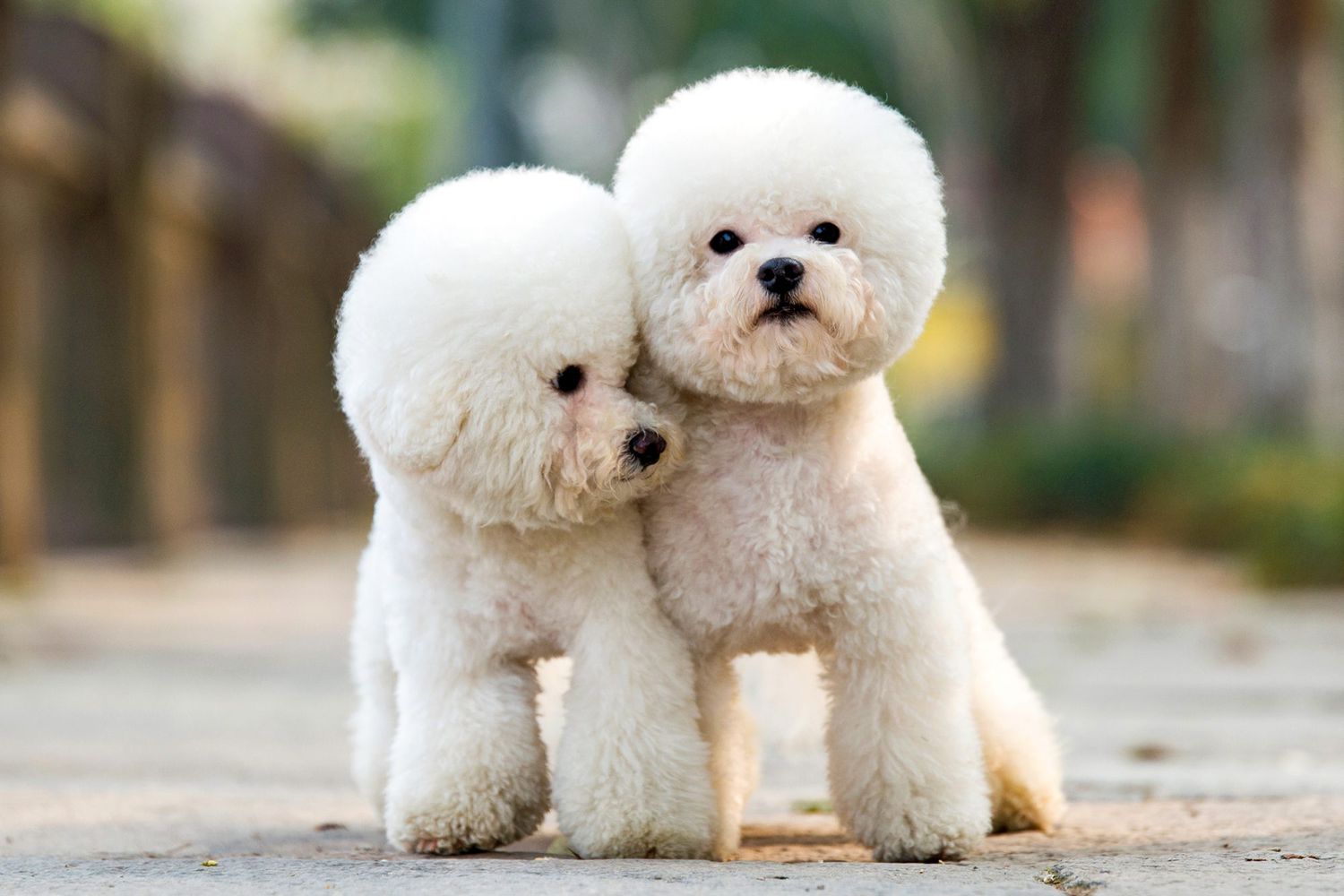
Poodles come in all sizes! Toy, miniature, and regular poodles are all of the same breeds. The only difference between them is their size. They’re very popular (number 8 on the AKC’s ranking list from 2013), and a Poodle’s temperament and behavior are very similar regardless of their size.
In fact, the poodles are the only breed that makes all three of our lists.
Poodles are at the very top of the dog family for intelligence. They were originally bred as a ‘water retrieval dog,’ or a dog that assisted hunters with waterfowl retrieval. It is probable that the name ‘poodle’ came from the German word ‘pudelhund’ (basically meaning ‘puddle-dog’ or ‘one who plays in puddles’).
The French recognized the Poodle’s inherent intelligence, and soon the Poodle was a mainstay at the French Circus. They’re so smart that they learn very quickly. They’re one of the easiest breeds to train. They’re also smart enough to know when you’re not serious, so they’re one of the easiest breeds to ‘un-train.’ Be consistent and firm, and you’ll both be better off.
Poodles need to walk every day. If you’re able to walk and exercise them regularly, they will be calm and ‘snuggly’ indoors. Interestingly, Poodles will be OK without a yard as long as they are exercised and their minds are regularly engaged. Poodles are loving and protective of their families. They are pretty decent watch-dogs and love to be with people. Toy poodles are tiny, and therefore they tend to be ‘snappier’ toward small children.
Toy Poodle Size and Grooming – Toy Poodles are any sizes up to ten inches high at the shoulder. They are tiny in every respect, light boned and not overly muscular. They will weigh in between 6-9 pounds in most cases. They need to be clipped every few months (in your choice of styles… be creative!) but shed very little even with longer hair. Brush daily to help avoid mats and keep any loose hairs under control.
#3 Shih Tzu
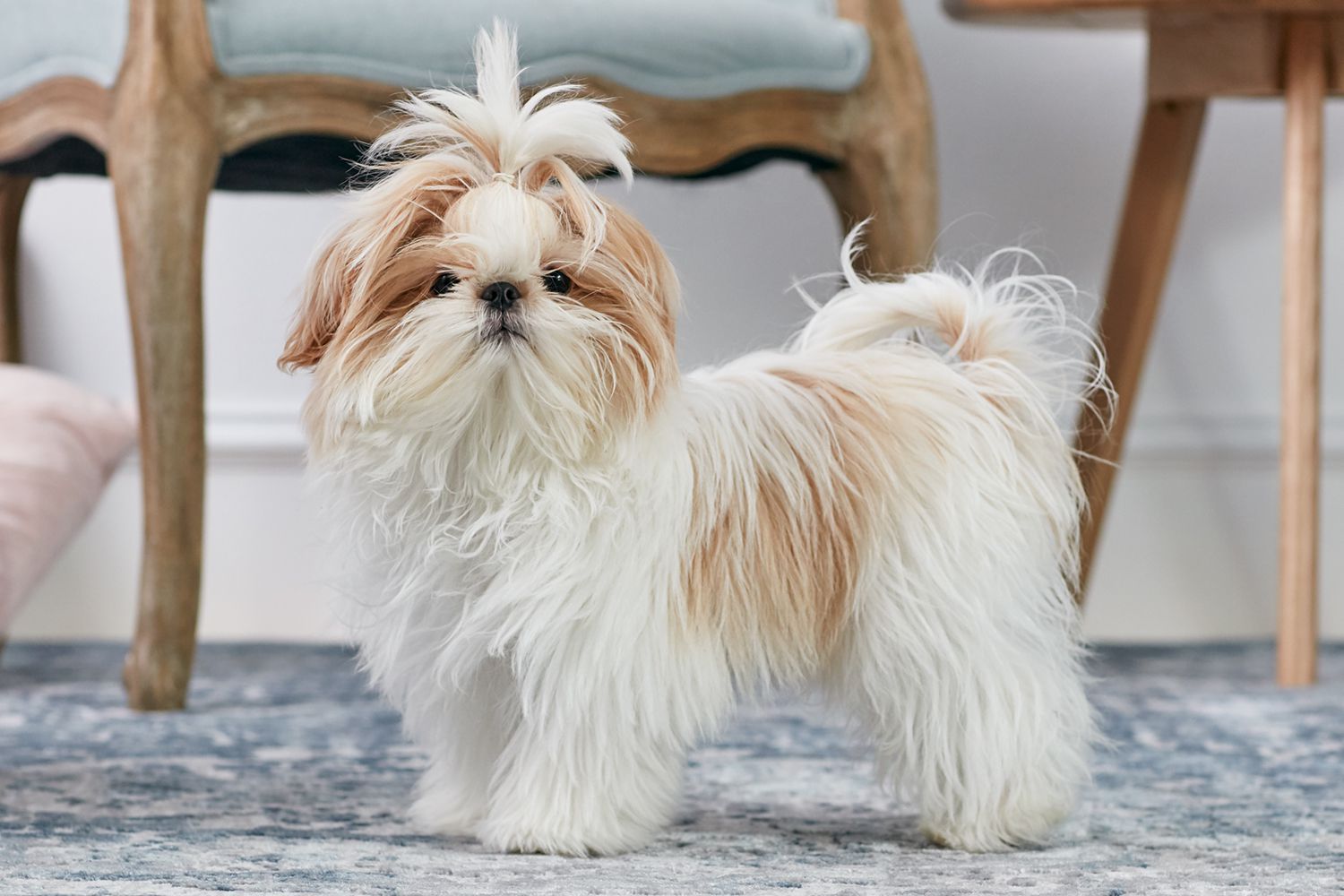
The Shih-Tzu is also known as the “Chinese Lion Dog” or the “Lion Dog”. The name Shih Tzu in Mandarin means ‘lion-dog’ because the breed was bred to look like traditional Chinese representations of lions. Its personality is very arrogant and regal for a tiny dog. In spite of this, however, Shih Tzus are extremely friendly.
This means that they play well with other pets and children. It also means that they aren’t the greatest watch dogs because they’re as likely to offer a stranger their friendship as their distrust.
If exercised regularly, Shih Tzus don’t require a yard. They do have a lot of energy, but they can often expend it pretty well in an indoor environment. Walking them once a day will help relieve pent-up energy and allow them new sights and smells.
They’re not easy to train, nor are they considered to be the most intelligent of breeds. If they’re allowed to think that they’re in charge of the house, they can become rude and grouchy. Keep a firm hand, and they’ll be much happier for it.
This is one breed that you’ll want to feed carefully. They have short legs and a long back, so overweight Shih Tzus often suffer from chronic back pain. Unlike a Dachshund, however, they can easily become obese from overeating.
In spite of these considerations, they’re among the most lovable and cuddly of our small breeds which makes them 15th on the AKC’s popularity list – a high mark for a lovely companion.
Shih Tzu Size and Grooming – Shih Tzus will grow up to 10 ½ inches at the shoulder, weighing in at a muscular 9-16 pounds. They must be brushed thoroughly every day, especially if their hair is allowed to grow. Tie back their facial hair to keep food and water from matting it and take care of the hair around their ears and eyes. If regularly brushed, they’ll shed little to no hair and almost no dander.
#4 Dachshund

Doxies are a wonderful and lively breed. They are courageous and loyal to the point of recklessness. They were originally bred to hunt and draw out badgers (which are much larger and much meaner).
They’re easily among the bravest and most stalwart of dog breeds, possibly the bravest if considered ‘pound for pound.’ They can tend to be aggressive toward strangers of both human and canine variety, making them great watchdogs.
Mixed in with the bravery is a healthy dose of stubbornness that can make them a chore to train. In spite of all that bravery, Dachshunds are also very sweetly dis-positioned toward those that they love.
They are gentle and patient with small children that they know and love but may be very short tempered with children that they don’t know. They desperately need companionship.If left alone, a Dachshund will whine or resort to destructive behavior. Love them a lot, and they’ll return your affection with fierce and undying devotion.
They love to chase things – small animals, tennis balls, toys or even socks. This is a great way to help them burn off excess energy and keep them healthy and happy. If you plan to be an active and engaging owner, a Dachshund is an excellent and rewarding choice. If you want a dog with no maintenance, it might be better to look for a more sedate temperament. Having said that, they’re among the most popular breeds in the US (number 10 on the AKC index).
Dachshund Size and Grooming – Standard and Miniature sizes are both relatively small, but Miniature is, of course, the smaller of the two. Standard sized Doxies are 8-11 inches tall at the shoulder and weigh 11 pounds or more. Some Doxies can weigh up to 30 pounds. Miniature Dachshunds are between 5-7 inches at the shoulder and weigh 11 pounds or less. Long-haired Doxies need a daily thorough brushing. Short-haired Dachshunds should be wiped down with a damp cloth daily. Wire-haired Doxies should be professionally trimmed twice a year. All breeds have very little dander when properly maintained.
#5 Lhasa Apso
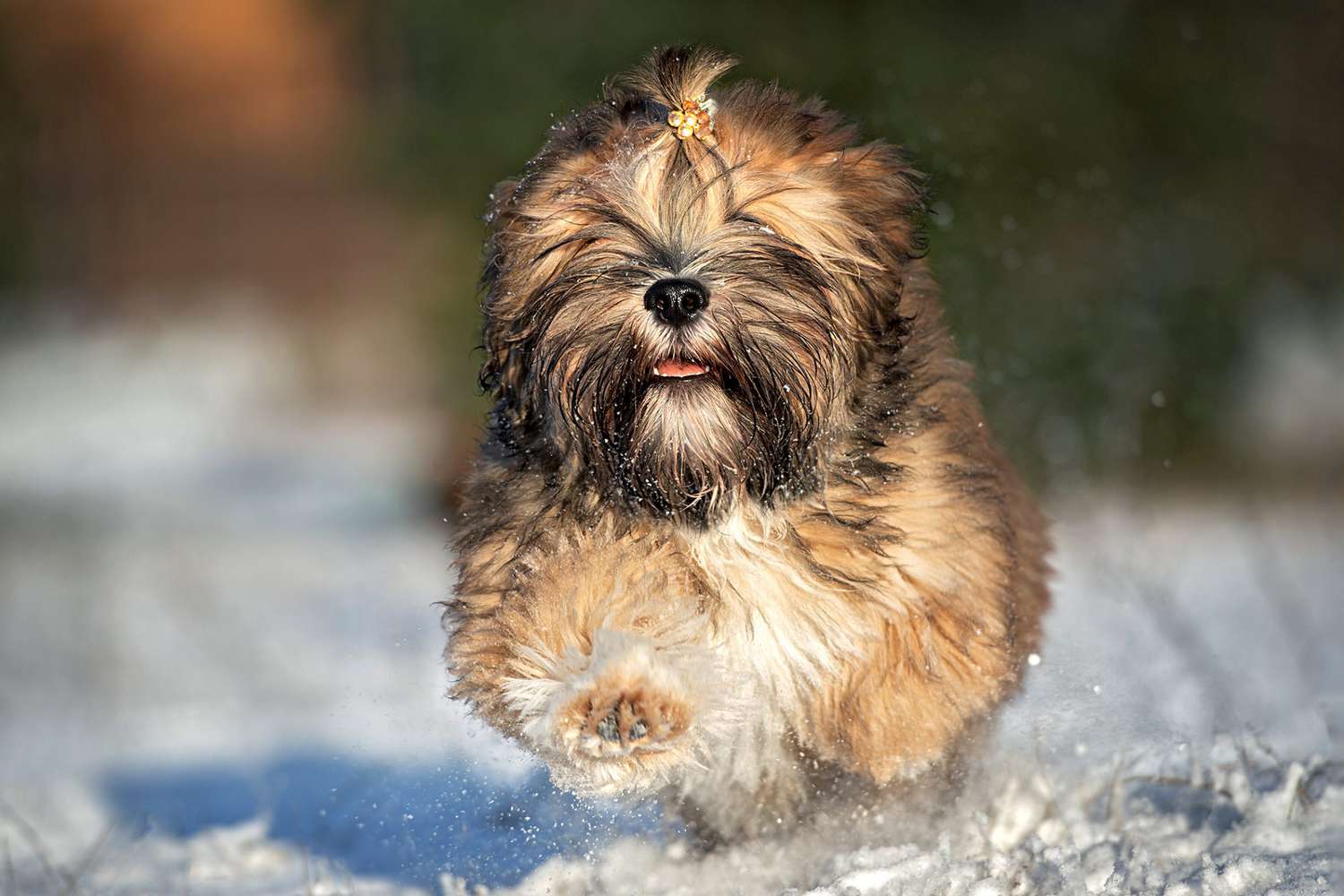
This alert and the entertaining breed is named for the capital city of Tibet, Lhasa. Apso means either ‘bearded’ or ‘goat-like,’ depending on the theory of etymology that one accepts. Either way, the name means ‘hairy or wooly Tibetan dog.’
This breed is one of the oldest known domesticated breeds, likely going back more than four thousand years. They were bred specifically to guard Tibetan monasteries and the homes of nobles.
They have a rich, deep bark for such a small dog, often surprising those unfamiliar with the breed. Lhasa Apso patrolled the mountains of Tibet, often paired with a Tibetan Mastiff.
The tiny Lhasa Apso were the eyes and ears for the larger, slower, much more powerful mastiffs. They are highly intelligent and suspicious of people that they do not know.
Of all the small breeds, the Lhasa Apso is likely the best watch dog of the group. It’s loyalty and fearlessness mean that it will never be cowed into submission. They aren’t easy to train, but they are very rewarding when they have a consistent command structure.
They need socialization and love, and they will often reciprocate that affection by ‘snuggling’ their owners. They are very hardy and are one of the longest living breeds of dogs with many cases of animals exceeding twenty years in age.
The average lifespan is roughly thirteen to fourteen years. Due to their watch-dog origins, they need to be walked daily, but probably require less exercise than the other breeds listed here. They are the least popular of our listed breeds, ranking 63rd on last years’ AKC list.
Lhasa Apso Size and Grooming – Lhasa Apso males stand about 10-11 inches tall at the shoulder and weigh around 15 pounds. The females tend to be a little smaller. Lhasa Apsos have a ‘double coat’ to combat the freezing conditions in the Himalayas that they came from. The short-haired under coat will shed once a year, but the outer long haired coat will not shed at all. These dogs have very little dander. With daily brushing, most allergy sufferers will be perfectly unaffected.
Honorable Mention: Terriers
It is worthy of note that while we have only one Terrier, the Yorkshire Terrier, in our top 5 small dogs, many of the terrier breeds share the same low allergy profile. These breeds include the Australian Terrier, Bedlington Terrier, Border Terrier, Cairn Terrier, Manchester Terrier, Scottish Terrier, Sealyham Terrier, Silky Terrier, Welsh Terrier, West Highland White Terrier and Wirehaired Fox Terrier.
Medium Sized Dog Breeds that Don’t Shed
#1 Miniature Poodle
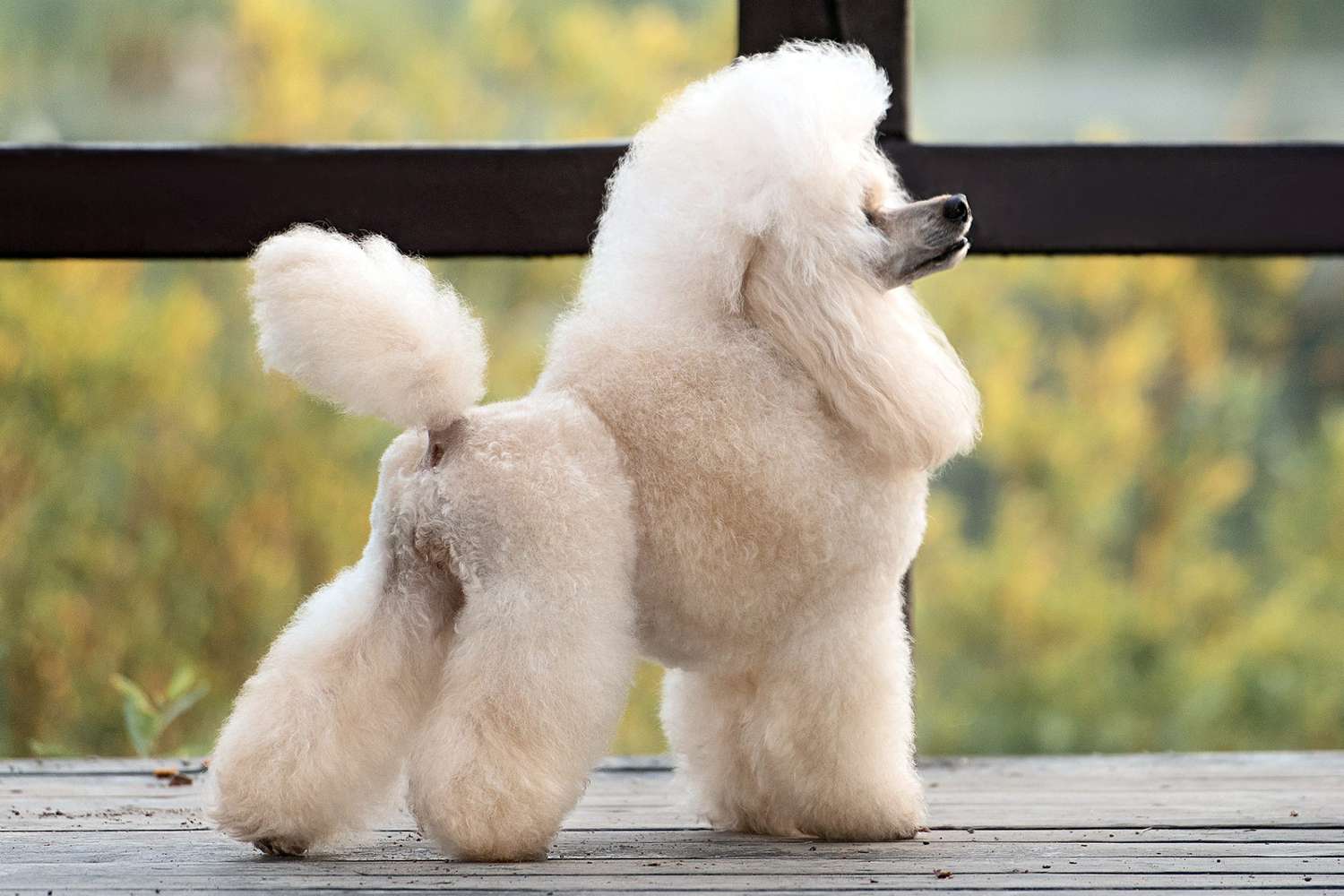
See the above entry on Toy Poodles for more information. Again, all poodles are the same breed apart from their size difference. The one major difference is that Miniature Poodles tend to be less aggressive toward children and other dogs – likely the result of a more confident sized animal.
Miniatures also need more exercise than their Toy siblings; be sure to give them lots of exercises, and they’ll still be quite well suited to indoor life, even in an apartment.
They tend to be quite calm indoors if they get enough exercise. Poodles are number one for medium sized dogs, but since we already talked about them, we’ll proceed to a full ‘Top 5’ below.
Miniature Poodle Size and Grooming – Miniature Poodles stand 11-15 inches tall at the shoulder. Weight varies (and is not a requirement for determining their ‘class’; only height is used for that), but they weigh around 15 pounds. For grooming tips, please reference the above entry about Toy Poodles.
#2 Portuguese Water Dogs
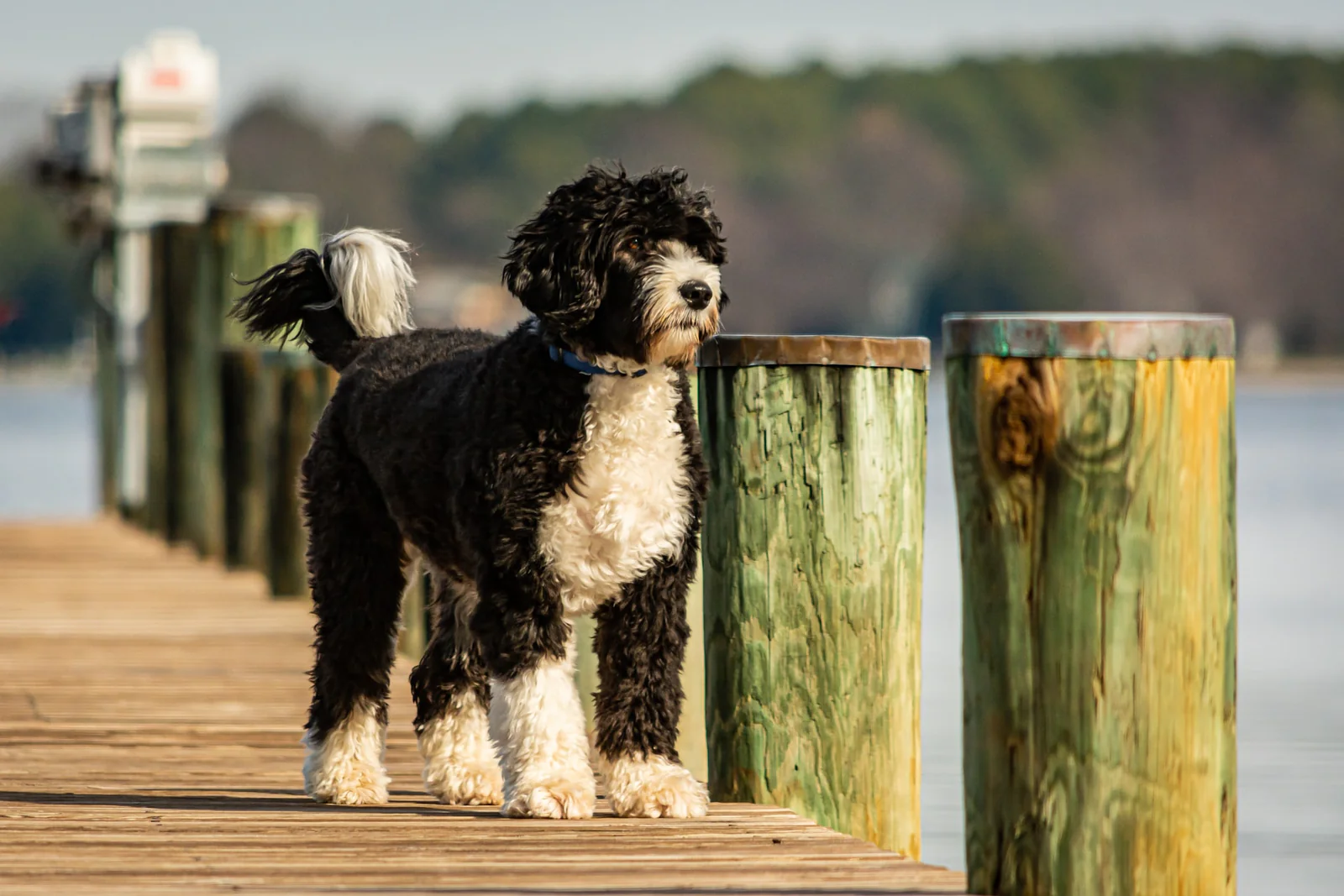
After Poodles, Portuguese Water Dogs are the second most popular allergy-free medium sized dog (#49 overall), and for a good reason: they have all the qualities that you’d want in a family animal.
They are loyal, very intelligent, easy to train, careful and protective of children and they get along easily with other animals.
The trade-off is that they are very sensitive to the attitude and tone of their owners.
Be gentle and firm, strong but calm. If an owner is immoderate in their approach, these wonderful animals can be ruined. Too strong and angry (or inconsistent) and you’ll have a very smart, loving dog that is afraid all the time. Too weak and the Portuguese Water Dog will think it can outsmart you.
One other downside is that they are prolific ‘chewers,’ particularly as puppies. Provide them with lots of chew toys or be prepared for the carnage to ensue. As their name suggests, they love water.
They came from Portugal where they were bred to work with the fisherman at sea. They helped with delivering messages and retrieving broken nets, oars or anything else that fell into the sea.
Some Portuguese Water Dogs were even trained to herd fish! Exercise often with long walks or swimming.
Portuguese Water Dogs Size and Grooming – The males measure 20-22 inches at the shoulder, females 17-20. Weight can vary in either gender, but males tend to be 42-55 pounds and females 35-49. Their hair grows even more slowly than a poodle’s with little to no shedding. Brush regularly to avoid mats and tangles – very low maintenance.
#3 Whippet
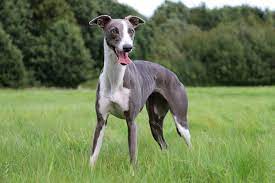
The Whippet is probably the most well-behaved of our medium dogs. Sweet and docile indoors, they are a whirlwind of energy when at play outside. They are devoted companions and very bright company; intelligent and relatively easy to train.
Whippets were originally bred as race-dogs and can reach speeds of up to 37mph! Needless to say, these dogs love to run and chase and need plenty of exercises.
Remember that a Whippet is bright and sensitive in mind and body: don’t be rough in your training or you risk harming your dog. They are excellent with children as long as the children don’t overly harass the animal. You have to earn a Whippet’s trust, so they are quite good as watch-dogs.
The downside to this side of a Whippet is that they will chase and kill almost any small animal that they see. A Whippet’s calm demeanor means that it is excellent in at traveling by car, boat or plane.
Whippet Size and Grooming – Whippets are between 18-22 inches tall at the shoulder and weigh in from 25-45 pounds. They are very clean, short-haired dogs with virtually no odor. They need to be wiped down regularly with a damp cloth to maintain the sheen of their fur. Brush with a bristle brush and bathe as needed. Whippets shed about as much as an average dog (which is more than most on this list), but they have very little dander – so are still very hygienic and virtually allergy free.
#4 Standard Schnauzer
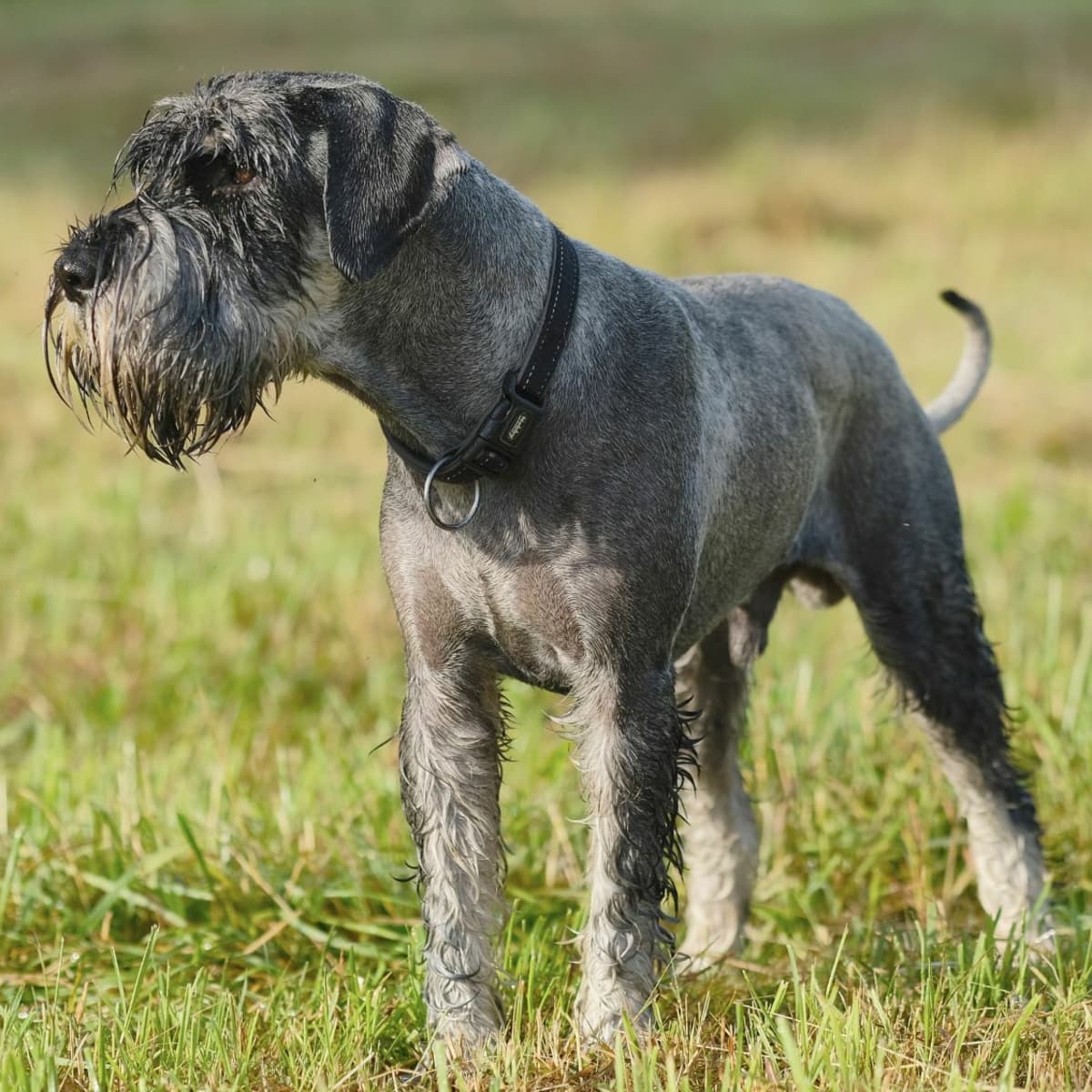
Like Poodles, Schnauzers come in all sizes. Standard Schnauzers are the most popular, mid-sized version of the breed.
Coming in at number 96 on the popularity index, Schnauzers are the best watch-dog of this group. As a matter of fact, the Red Cross and German and American Police forces have all used Standard Schnauzers in an official ‘guard dog’ capacity.
They are spunky, confident dogs who learn very quickly. Be confident and firm or risk losing all boundaries.
While some Schnauzers can be good with children, their demanding nature means that, as a whole, it’s unwise to have them around small children. They can be a very aggressive blend of dominating and aggressive; children usually don’t have the mental and physical fortitude to make sure that Schnauzers stay in their ‘place.’ Having said that, they are excellent companions, loving and loyal to a firm owner.
They also have an excellent tolerance of travel. Keep them well exercised with a walk and play time daily to ensure that they stay happy and healthy.
Standard Schnauzers Size and Grooming – Standard Schnauzers are from 17-19 inches tall at the shoulder and weigh anywhere from 30-45 pounds. They have two different grooming procedures: clipping or stripping out.
Twice a year a Schnauzers coat will become dull and easy to pull out (said to ‘have blown’). Pulling this out by hand or with a wire brush will allow the more wiry, weather resistant coat to reemerge later. Clipping, on the other hand, should also be done twice a year and will result in a much softer coat. Either way you choose to go, shedding should remain minimal if regular brushing is pursued.
#5 Irish Terrier
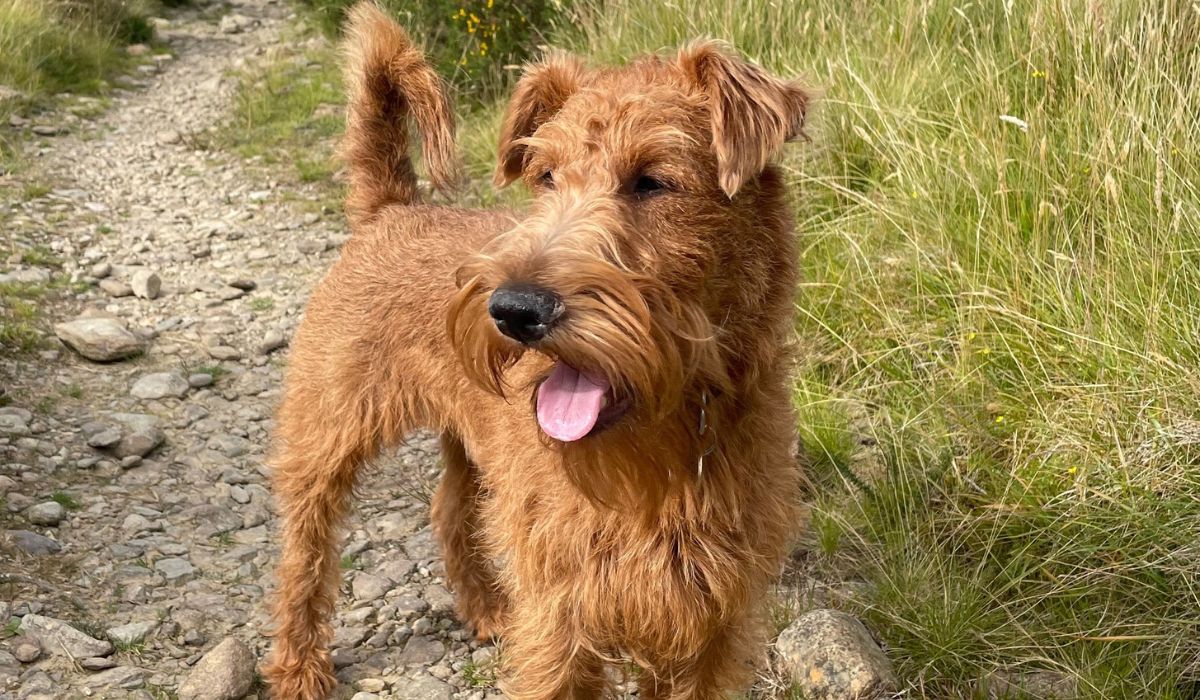
This is another very old, very true breed. It’s probably the oldest of the terriers, bred as work and hunting dog in the UK.
They need a lot of exercises, requiring at least a long, brisk walk each day. One important note is that the Irish Terrier must be made to heel or follow on this walk to maintain a good order to the relationship.
In an Irish Terrier’s mind, the leader in a walk is the leader in the relationship. When well exercised, this animal is surprisingly well-behaved indoors.
They are one of the better breeds to have around children as they are both hardy enough to endure (and enjoy) rough play and patient and protective enough of their young charges not to lash out when tested.
Their very strong protective instincts make them good watch-dogs, but also require strong leadership from their owners. Their stubbornness means that training must start as a puppy and be very firm to be effective.
Irish Terrier Size and Grooming – Irish Terriers, are about 18 inches in height at the shoulder and weigh around 25 pounds. Like the Schnauzer, Irish Terriers require coat ‘stripping’ once or twice a year. They should not, however, be clipped. Bathing should be only on an as-needed basis, but brushing should be regular. Shedding is very minimal if properly maintained.
Bonus Entry – Petit Basset Griffon Vendeen
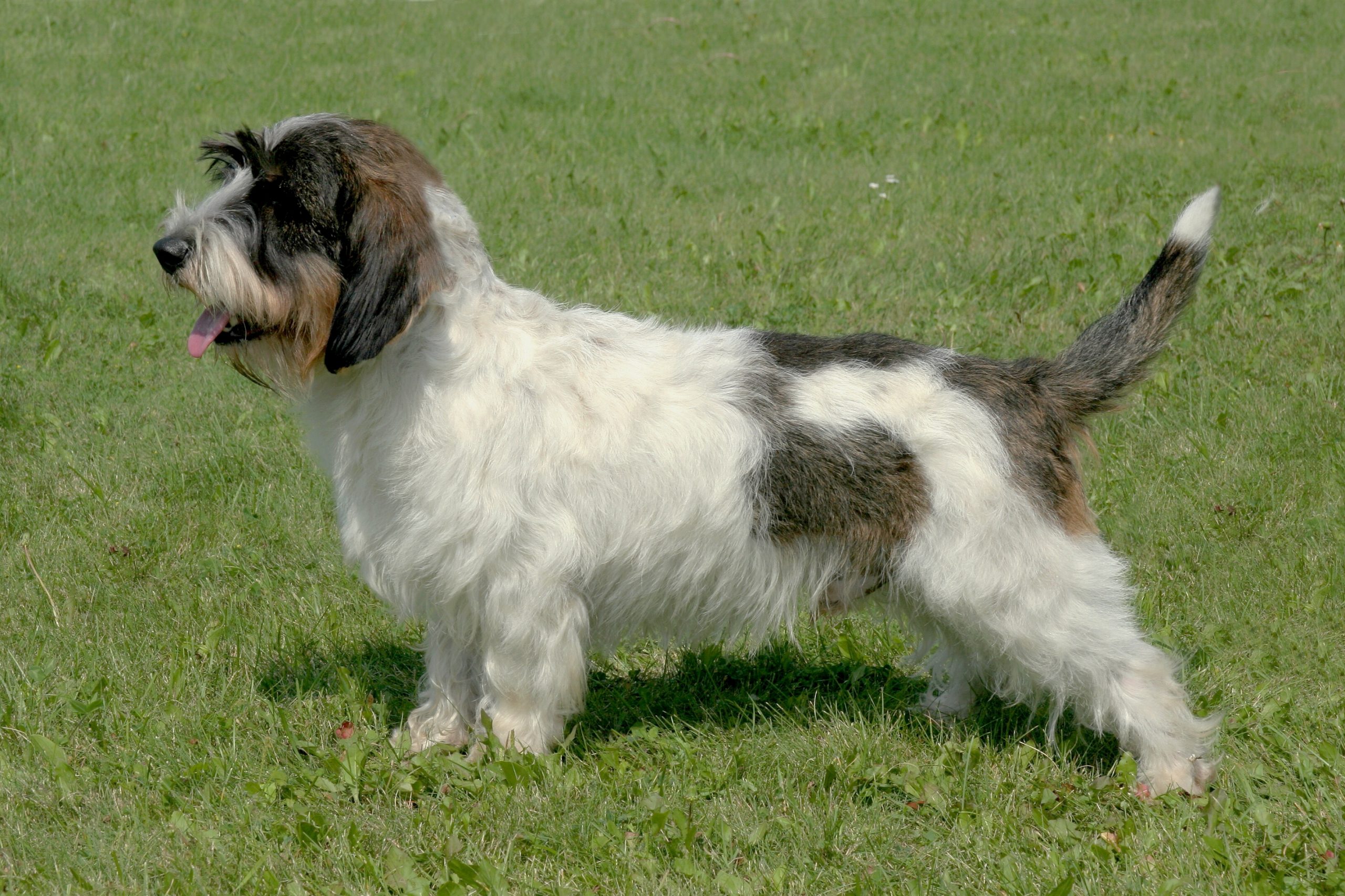
For the most exotic of our entries, we turn to the long-haired, long-bodied Vendeen. The Petit Basset Griffon Vendeen, or PBGV, was originally bred as a hunting hound.
They have charming and lovable personalities, sometimes even being referred to as ‘the happy breed.’ They are not quiet dogs, with a full and rich hound’s voice that is surprising in a smaller frame. PBGVs are not solitary animals and, if left to their own devices, will display their loneliness or boredom in ways that can sometimes be comical or destructive.
Typical to hounds, they are quite stubborn. Firmness and consistency can create a companion that is among the friendliest and happiest of all breeds.
Exercise daily with a good walk or restlessness will manifest its ugly, ‘chewy’ head. These dogs are ‘scent hounds,’ so be sure to leash during your walk. While PBGVs are very good with most children, small children and infants may not be a good idea as the PBGV likes to ‘play bite.’ They can be escape artists, so a good fence is a necessity.
Petit Basset Griffon Vendeen Size and Grooming – PBGVs stand 13-15 inches high at the shoulder. They weigh roughly 30-40 pounds. Brush your PBGV weekly to remove debris and keep hair from matting. The PBGV sheds very little with weekly brushing. Bathe as needed.
Large Dog Breeds that Don’t Shed
#1 Airedale Terrier
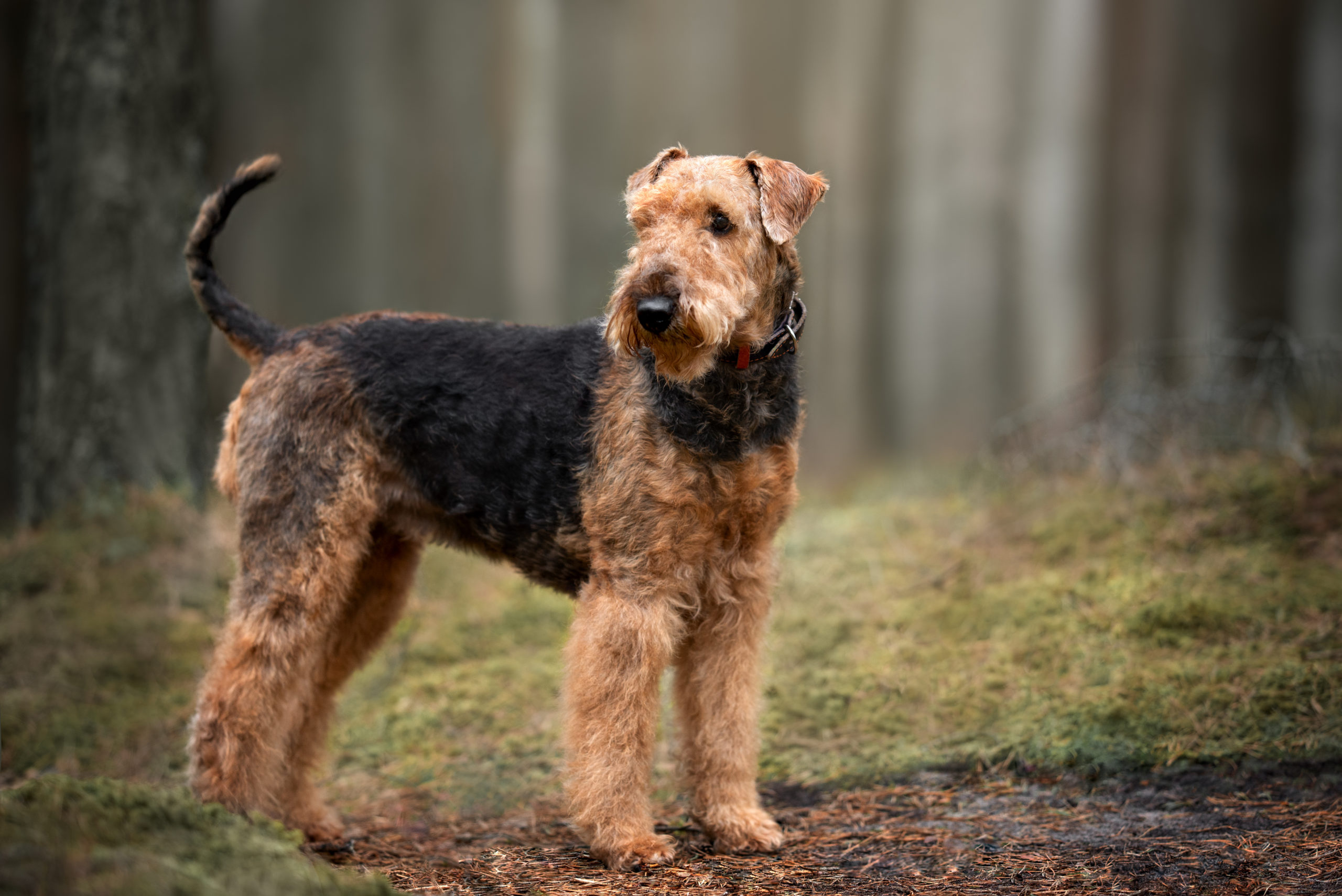
The Airedale Terrier is the largest of all the Terrier breeds. It inherits the playful demeanor and intelligence that defines the Terrier family, but its size means that it will need a firm and experienced trainer.
They love to hunt, willingly chasing any small animal that crosses their path. For this reason, it is wise to keep them leashed or in a yard. They can be kept indoors effectively if exercised extensively and trained on a regular basis. The training should be varied as the Airedale is smart enough to become bored with repeated commands to perform ‘old tricks.’
Keep a healthy variety, and your Airedale will surprise you with its ability to learn and retain complex concepts. Loyal, fun-loving and playful, Airedale Terriers are not naturally aggressive unless they are poorly trained or trained specifically as guard dogs.
This natural tendency to playfulness means that they tend to do well with children. Having said that, Airedales, like other Terriers, are ‘jumpers’ and must be carefully trained not to jump on humans. They are popular enough to rank 56th on the AKC popularity index, highest of all our large dogs with the exception of the Poodle.
Airedale Terrier Size and Grooming – Airedale Terriers, are the largest of the Terrier family, growing to substantial 22-24 inches tall at the shoulder. They can weigh anywhere from 40-65 pounds, though females tend to be 45 pounds or less. Airedales should be brushed thoroughly every day, ‘stripped’ twice a year and had their beards washed daily. While they shed more than other animals on this list, they have the Terrier tendency to little dander – meaning they can be quite good for allergy sufferers in spite of the shedding.
#2 Bouviers des Flandres
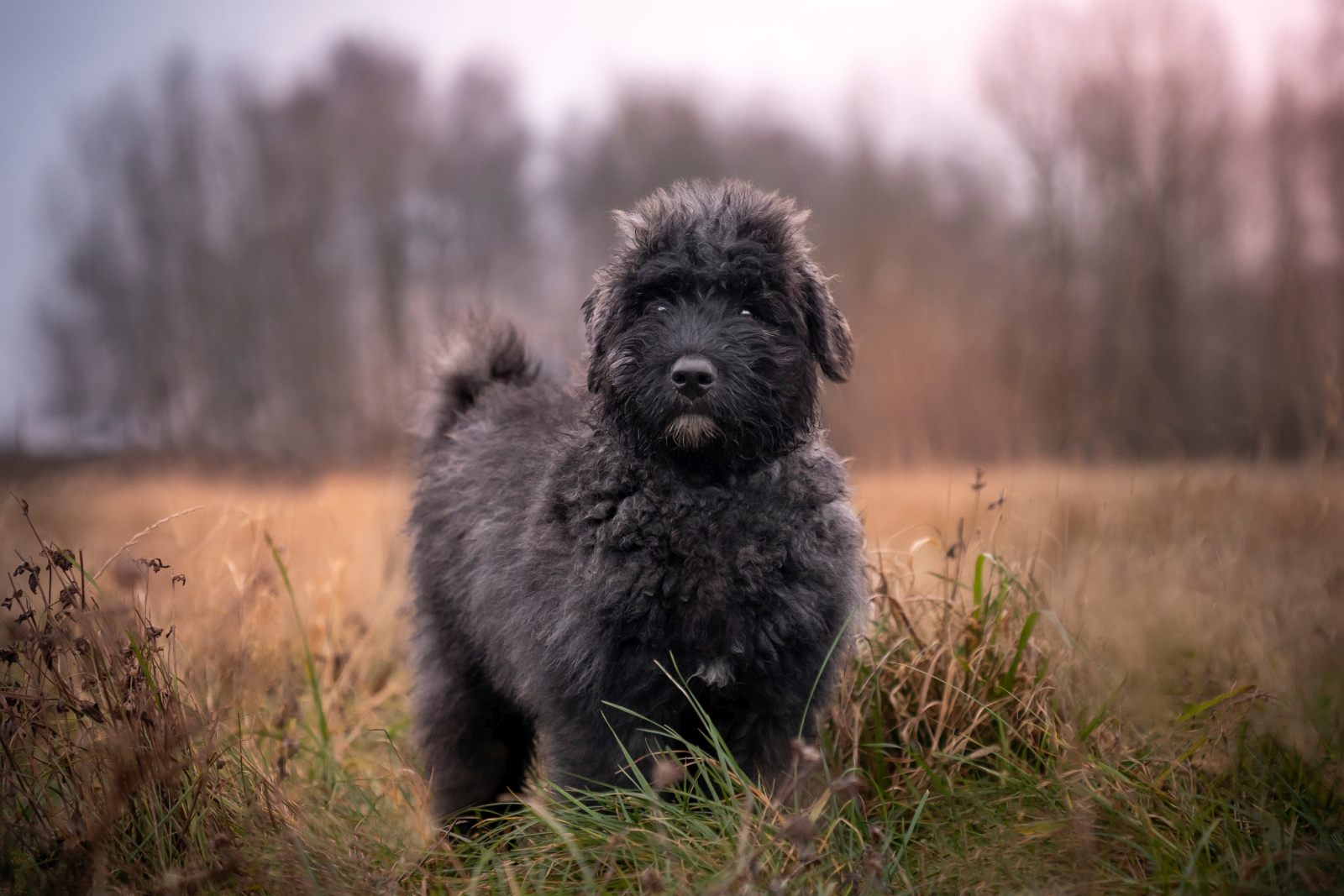
This regal animal is number 86 on the AKC index. Bred to be a working dog in Belgium and France, this dog is much more of a herder than a hunter. Pleasant natured and gentle to those that know them, they make excellent watch-dogs.
They are very easy to train, almost intuitive in their understanding. Best of all, once they learn a command, they’ll likely remember it for the rest of their lives. They are among the most loyal of dogs, and they like and enjoy being around children. Their loyalty and protective natures do mean that a firm and the consistent owner is needed.
It’s easy for a Bouviers des Flandres to become over-protective and aggressive toward strangers or anything that it sees as a threat toward its family. A good brisk walk or run daily will keep your Boviers des Flandres calm and docile indoors.
Boviers des Flandres Size and Grooming – This breed is quite substantial, standing 22-28 inches tall at the shoulder and weighing in at a stocky 60-110 pounds. Grooming, as might be expected in a long-haired breed, is very important to the dog’s cleanliness. Brush thoroughly every day and bathe as needed. Boviers des Flandres will need three or four trims a year as well.
#3 Standard Poodle
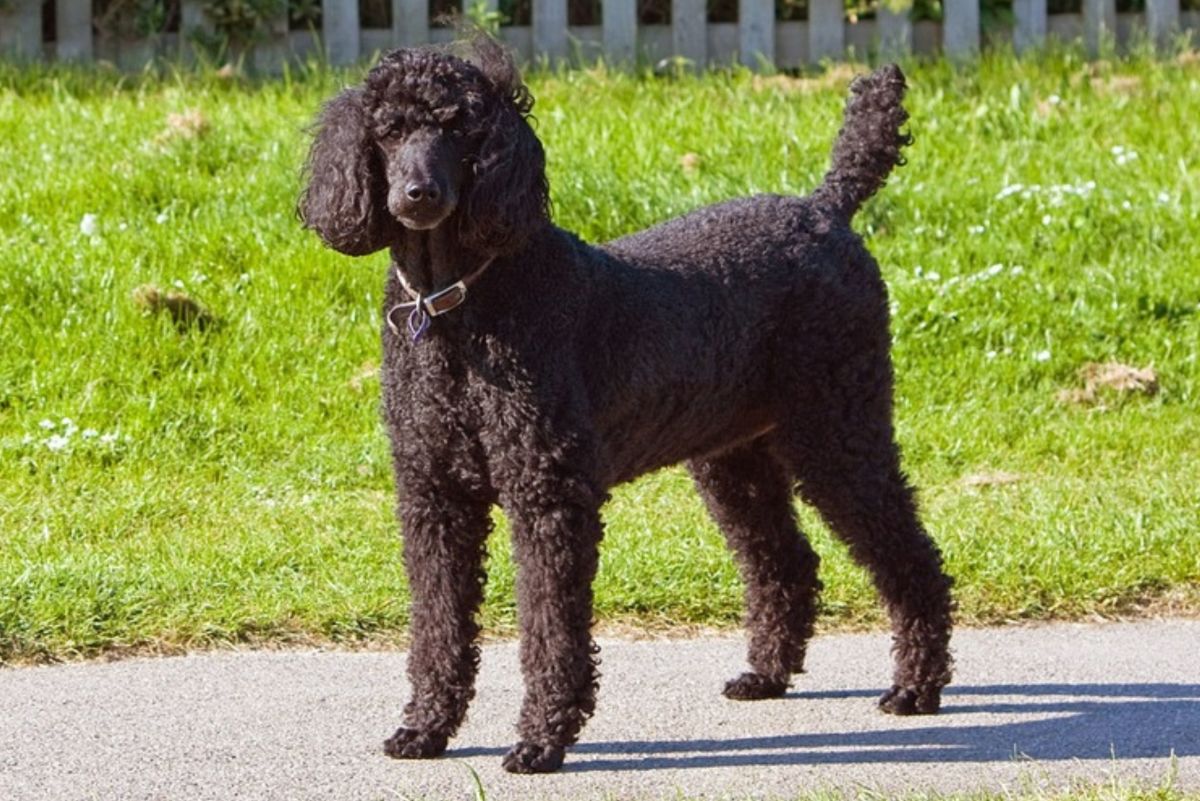
While the Poodle is the most popular of the large pure-bred dogs on our list, it’s also a breed plagued with health problems.
In spite of the health issues, large Standard Poodles share all the wonderful qualities of their smaller siblings but have the added benefit of being tempered by their size. Like large dogs, they tend to be calmer and less aggressive.
Since we’ve already discussed Poodles at length, we would like to point out that any Poodle crossbreed tends to retain the Poodles low allergy profile, while gaining the more stable health profile of other less specialized breeds.
Some of these breeds that you may want to consider would be Goldendoodles, Labradoodles, and Schnoodles. For a truly giant indoor allergy-free pet, check out Great Doodles or Newfypoos: crosses of Great Danes and Newfoundlands respectively.
Standard and Cross-Bred Poodle Size and Grooming – The size of the animal can vary wildly, but the best determining factor is the size of the parents. For Standard Poodle, grooming sees the notes on Toy Poodles. For the cross breeds, grooming will vary.
#4 Saluki
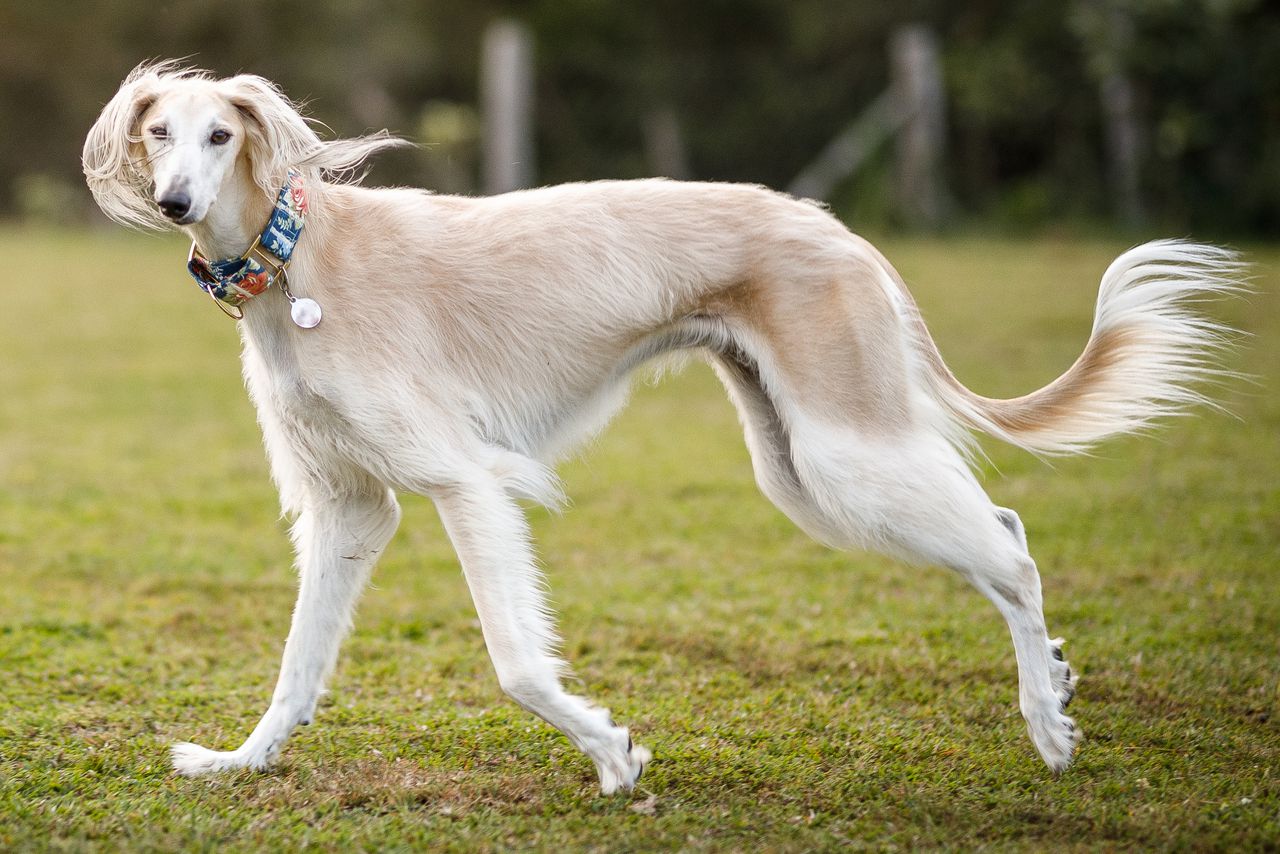
The Saluki is also called the ‘gazelle hound’ or ‘Persian greyhound.’ It is one of the oldest and most noble of dog breeds. Salukis have been found mummified and preserved with great care in the tombs of the Pharaohs.
They are still the royal dog of Egypt and are honored in many middle eastern countries, even considered to be sacred by some. The Saluki’s distinctive profile features in many ancient Egyptian tomb paintings. Salukis were bred as ‘sight hunters’ and are extremely fast, reaching 40mph in short spurts.
They have a lot of energy and need to be exercised extensively. Be careful during exercise to keep your Saluki on a lead: if it sees a small animal, even the best-trained animal is helpless against its instincts and will not hear or see anything but its prey. In spite of its thrill for the chase, Salukis are gentle, docile and even-tempered.
They are good with children unless treated roughly. They’re good with other dogs, but beware their hunter’s instinct with any non-canine animal that is their size or smaller. They’re #115 on the AKC popularity list.
Saluki Size and Grooming – Salukis size vary significantly. They stand anywhere from 23-28 inches at the shoulder and weigh anywhere from 29-66 pounds. Grooming is among the easiest of the dogs listed here: comb or brush occasionally and wash only as needed. Salukis are virtually odor and dander-free, though they do shed moderately.
#5 Wirehaired Pointing Griffon
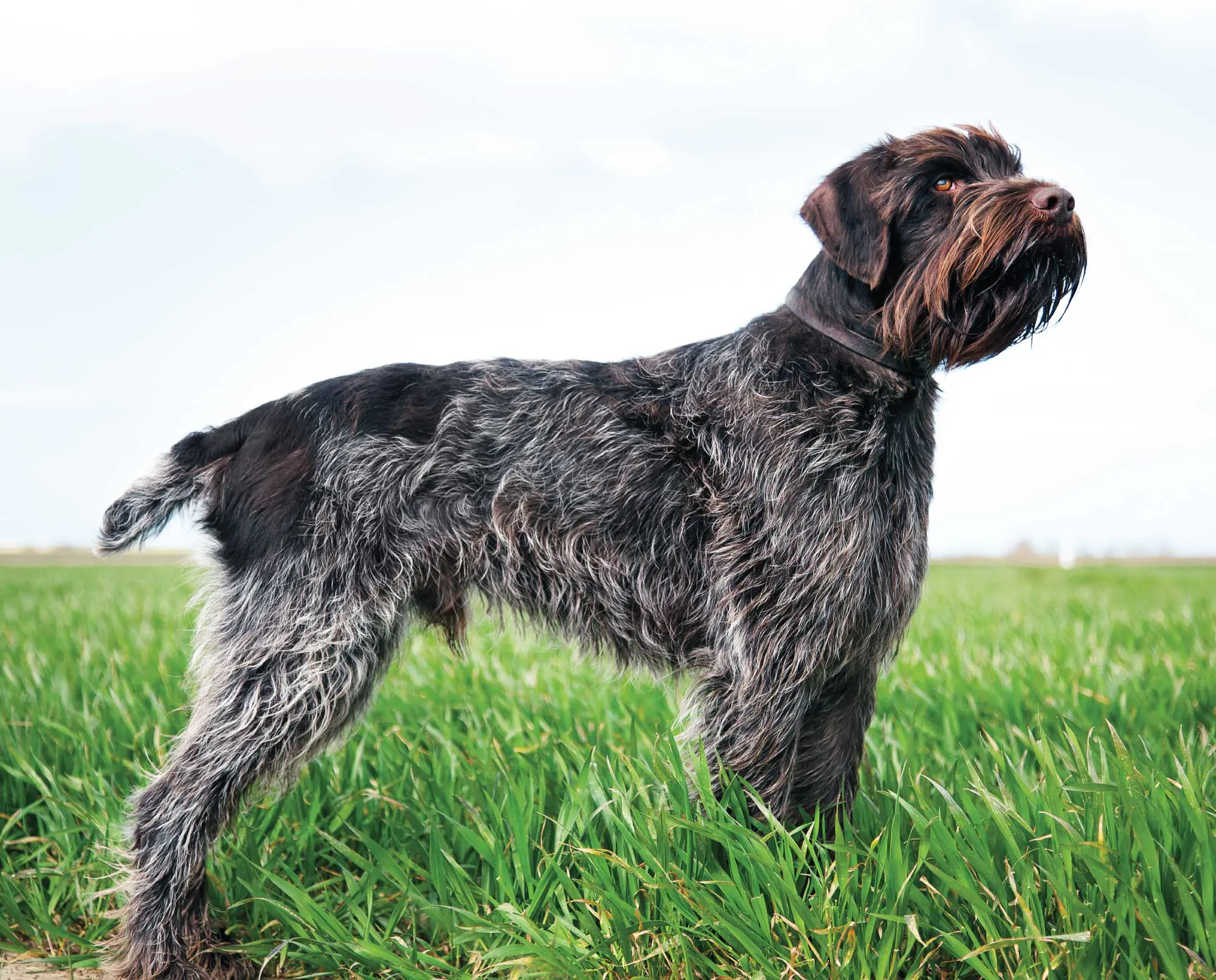
At number 80 on the AKC popularity index, Wirehaired Pointing Griffons are strong, loyal and skilled hunting dogs. They are very intelligent and were bred to be both tracking and ‘gundogs’ or retrievers.
They have an exceptionally fine sense of smell and exceptional reasoning skills. They are friendly, active and very loving. They are gentle and protective of young children that they know.
As with many breeds, they can be distrustful of strangers or in unfamiliar situations. Wirehaired Pointing Griffons are excellent watchdogs for this reason: if a more socially trusting temperament is desired, be sure to expose the animal to varied people and environments when very young to overcome its natural tendencies toward mistrust.
This animal is highly active in general and needs a sizable yard even with heavy exercise. We don’t recommend keeping a Wirehaired Pointing Griffon in an apartment or townhouse for these reasons. If you have space, they’re a very rewarding and loving companion.
Wirehaired Pointing Griffon Size and Grooming – Wirehaired Pointing Griffons, stand 20-24 inches tall at the shoulder. They weigh in at a solid 50-60 pounds. Wirehaired Pointing Griffons do not shed but should be brushed once a week and ‘stripped’ twice a year so that new hair can replace the old.
Tips for Handling Dog Hair and Reducing Allergens
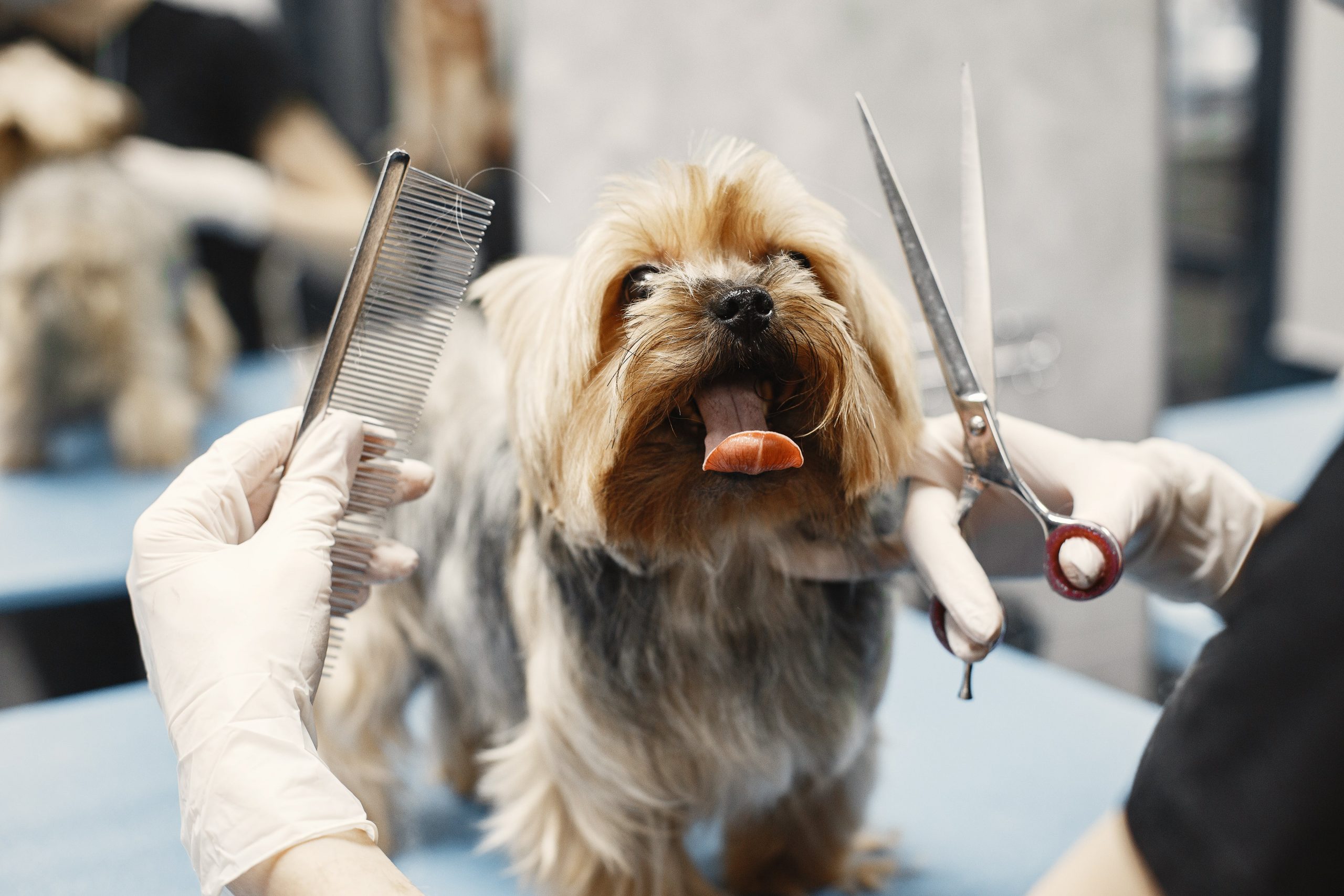
•The first and most important tip is to brush regularly. With any breed and any level of dander, hair is the way it gets into the air (and then into your airways). Control the loose hair, and you’ve won half the battle. It’s also much better to brush your dog outdoors when you can.
•Next, clean your dog’s bedding frequently. If you brush and wash your dog and then it goes back to its old bedding, you’re undoing all the work you just did. Even though this seems obvious, it’s one of the most overlooked steps in protecting yourself from an allergen ridden environment.
•Regular bathing is the best way to control dander itself. Remember that dander is dead skin cells: a good shampoo and scrub down can help a lot with reducing dander output. Some dogs need to be wiped down (short-haired Dachshunds for example) instead. Be mindful of the special requirements of your breed’s coat when planning your bath schedule.
•Feed your dog a healthy diet to help ensure a healthy coat. Generally speaking, the more sickly your dog is, the more they’ll shed. It’s a worthy investment to get premium foods that will keep your dog’s coat and skin in the best and healthiest shape that it can be.
•It’s a wise plan also to choose at least one room to be a ‘dog-free zone.’ If you suffer from allergies (and we assume you do since you’re reading our tips to handle allergies), it’s probably a good plan to make that room your bedroom. This will give your airways the maximum rest from airborne allergens and allow your body to refresh and rebuild for another wonderful day with ‘man’s best friend.’
•HEPA filters are a big help in two different applications: HEPA air filtration and HEPA filtered vacuum cleaners. The air filtration systems can be installed as a central unit (similar to central air-conditioning and using the same vents) or used locally. Use a filter in the dog’s main room a couple of hours a day for best effect. Vacuuming regularly is also good, but be careful: if your vacuum doesn’t have a HEPA filter, you’re likely stirring up a bunch of hidden dander into the air. Be sure to get a vacuum with a good filter, so you don’t make matters worse inadvertently.
•As a final resort for the dog lover who is suffering horrible allergies, wash your hands after every interaction with your pet. Normally this isn’t something that you’d need to do, but your hands will transfer dander to your face. If you’re forced to this exigency, washing your hands a little more often is a minor price to pay for the love and affection of a wonderful animal.






